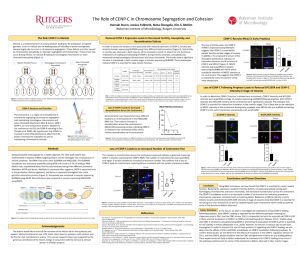Sturm, Hannah: The Role of CENP-C in Chromosome Segregation and Cohesion
Title: The Role of CENP-C in Chromosome Segregation and Cohesion
Name: Hannah Sturm
Major: Genetics
School affiliation: School of Arts and Sciences
Programs: Honors College with Johnson & Johnson Women in STEM2D Life Sciences Summer Undergraduate Research Fellowship (HCW-SURF)
Other contributors: Jessica Fellmeth, Neha Chengala, Kim S. McKim
Abstract: CENP-C is an inner kinetochore protein which serves as a critical link between the centromere and kinetochore. Previous experiments have shown that CENP-C binds to CENP-A, a histone H3 variant which makes up the structure of the chromatin in the centromere, and has been shown to play a role in the chromosome bi-orientation and the attachment of spindle fibers to the kinetochore (Tanaka, Chang, Kagami, & Watanabe, 2009). While CENP-C function has been investigated in mitotic studies, there is a gap in the literature concerning the role of CENP-C in meiosis. Therefore, this study analyzed the early meiotic function of CENP-C in retaining the cohesin complex and establishing the kinetochore. Using Drosophila melanogaster as a model organism, the UAS/ Gal4 system was used to express shRNA’s targeting CENP-C in order to investigate the meiotic consequences. Lack of CENP-C expression lead to a decrease in fertility, an increase in aneuploidy, as well as reduced recombination. Cytological analysis revealed an increase in centromere foci consistent with a loss of cohesion. The knockdown also resulted in a failure to recruit the kinetochore protein MIS12 in early meiotic oocytes as well as a reduction in SPC105R attachment in late meiotic oocytes. This experiment allows for a better understanding of CENP-C function in meiosis and evaluates a potential mechanism for meiotic errors which have biological implications such as female infertility and genetic disease.
